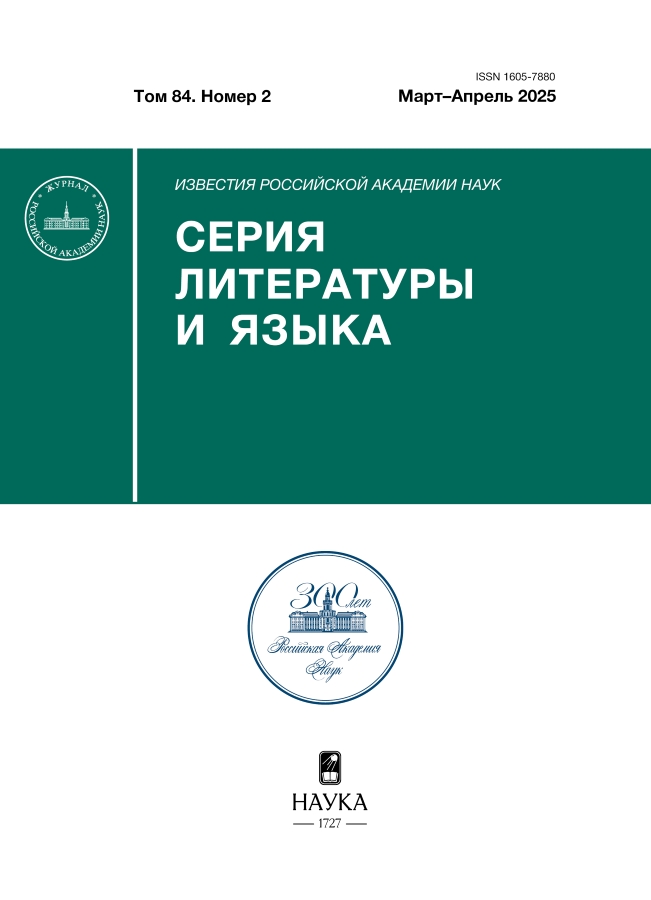“Osman” (1647) by Tristan LʼHermite: a classic tragedy with romantic conflict. On the problem of poetological possibilities of the dramatic text of classicism
- Авторлар: Simonova L.A.1
-
Мекемелер:
- Library named after A.S. Pushkin
- Шығарылым: Том 84, № 2 (2025)
- Беттер: 61-79
- Бөлім: Articles
- URL: https://ruspoj.com/1605-7880/article/view/684274
- DOI: https://doi.org/10.31857/S1605788025020067
- ID: 684274
Дәйексөз келтіру
Аннотация
The article examines the dramatic work of Tristan LʼHermite, defines his exceptional place in the history of French classical tragedy. Due to the heterogeneity, “eclecticism” of his dramatic writing, which combines archaic elements of the pre-classical tragedy of the 16th century and new principles of discursive and rhetorical construction of the text, LʼHermiteʼs plays visibly differ from those forms of the tragic genre, within the boundaries of which it functions in the first half of the 17th century in the works of P. Corneille, J. Mairet, J. de Rotrou, J. de Scudery and other contemporaries of the author. In Kermit plays, the nature of the tragedy of these periods is clearly traced: the Racine (“The Death of Crispus”), the educational (“The Death of Seneca”) and the romantic (“Osman”). In “Osman”, LʼHermite showed the exhaustion of the historical plot, as it was developed by the classic tragedy with its heroic and political ideological foundation, and brought out a new type of hero, whose exclusivity is revealed in his opposition to an inert, undignified crowd and whose power is not evidence of social status, role-setting behavior, but an expression of his spiritual potencies and efforts of will/action in achieving an fundamentally unrealizable ideal (both in politics and in love). Osmanʼs behavior is an insistent demonstration of pride, a desire for absolute freedom in overcoming any obstacles, a challenge to the impossible. LʼHermite has found a new nature of the tragic conflict – the incongruity of the personality with historical time, in its essence antiheroic, absurd.
Негізгі сөздер
Толық мәтін
Авторлар туралы
Larisa Simonova
Library named after A.S. Pushkin
Хат алмасуға жауапты Автор.
Email: mouette37@yandex.ru
ORCID iD: 0000-0001-7019-0215
Cand. Sci. (Philol.), Senior Researcher
Ресей, 9 Spartakovskaya Str., Moscow, 105066Әдебиет тізімі
- Bernardin N.-M. Un précurseur de Racine. Tristan LʼHermite, sieur du Solier (1601 – 1655). Sa famille, sa vie, ses œures. Thèse pour le doctorat, présentée à la Faculté des lettres de Paris. P.: Picard, 1895. 632 p.
- Sage P. Le préclassicisme. P.: Del Duca, 1962. 487 p.
- Schweitzer Z. La Mort de Sénèque: adieu à Sénèque ou continuation du théâtre humaniste? Cahiers Tristan LʼHermite. Tristan et le théâtre du XVI-e siècle. 2020. № 40. P. 19–29.
- Fournial C. Lʼinvention tragique de Tristan LʼHermite. Retour cyclique ou inspiration sérielle. Cahiers Tristan L`Hermite. Tristan et le théâtre du XVI-e siècle. 2020. № 40. P. 31–47.
- Berregard S. Le parcours théâtral de Tristan au regard de lʼexemple cornélien. Cahiers Tristan LʼHermite. Tristan et le théâtre de son temps. 2008. № 30. P. 37–47.
- Carriat A. Préface. Tristan LʼHermite. Choix de pages. Limoges: Rougérie, 1959. P. 9–17.
- Guichemerre R. Deux conseilleres perfides dans le théâtre de Tristan. Cahiers Tristan LʼHermite. Tristan et la politique. 1994. № 16. P. 21–28.
- Mallet N. Osman et les politiques. Cahiers Tristan LʼHermite. Tristan et la politique. 1994. № 16. P. 31–40.
- Moncondʼhui D. Éblouissement et désillusion: représentation du politique dans le théâtre de Tristan. Cahiers Tristan LʼHermite. Tristan et la politique. 1994. № 16. P. 5–11.
- Arland M. Préface. Tristan LʼHermite. Le Page digracié. P.: Stock, 1946. P. 11– 61.
- Abraham Cl. Préface. Tristan LʼHermite. Œuvres complète. T. IV. Les Tragédies. P.: Champion, 2001. P. 12–28.
- Forsyth E. La tragédie de Jodelle à Cornelle (1553–1640): le thème de la vengeance. P.: Nizet, 1962. 528 p.
- Carriat A. Préface. Tristan LʼHermite. Théâtre complet. Alabama, University of Alabama Press, 1975. P. III–XII.
- Berregard S. Tristan LʼHermite, “heritier” et “precurseur”: imitation et innovation dans la carrière de Tristan L’Hermite. Tübingen: Gunter Narr Verlag, 2006. 480 p.
- Forestier G. Essai de génétique théâtrale: Corneille à lʼœuvre. Genève: Droz, 2004. 392 p.
- Fumaroli M. Héros et Orateurs. Rhétorique et dramaturgie cornélien. Genève: Droz, 1996. 532 p.
- Mallet N. Introduction dʼOsman. Tristan LʼHermite. Œuvres complètes. T. IV. Les Tragédies. P.: Honoré Champion, 2001. P. 454–461.
- Fort S. Le héros et l`Histoire sur la scène romantique. La pesanteur et la disgrâce // Littérature. 1999. № 41. P. 159–181.
- Tristan L`Hermite. Osman. P.: Éditeur Guillaume de Luznes, 1656. 198 р.
- Dalla Valle D. Introduction. Tristan LʼHermite. Œuvres complètes. T. IV. Les Tragédies. P.: Honoré Champion, 2001. P. 5–17.
- Dalla Valle D. Il Teatro di Tristan LʼHermite. Turin, Giappichelli, 1964. 339 p.
- Laubner J. “Tant de chimères et de monstres fantasques”. Les visions intérieures dans les tragédies Tristan LʼHermite. Cahiers Tristan LʼHermite. 2017. № 39. P. 41–55.
- Mallet N. Les plaintes de la mal-aimée: passion et scénographie dans la tragédie dʼOsman. Cahiers Tristan LʼHermite. 1998. № 20. P. 17–27.
- Mazouer Ch. La vision tragique dans La Mariane, La Mort de Sénèque et La Mort de Crispe de Tristan. Cahiers Tristan LʼHermite. Tristan et le théâtre du XVI-е siècle. 2000. № 22. P. 4–16.
Қосымша файлдар









